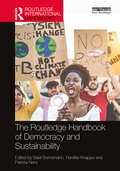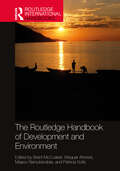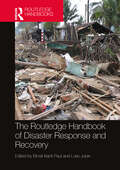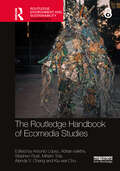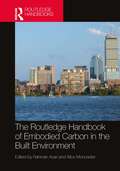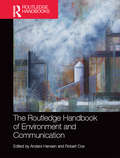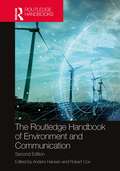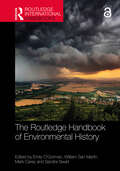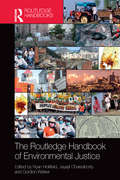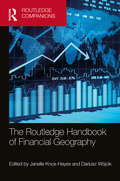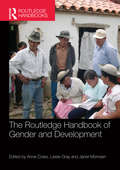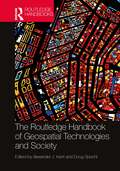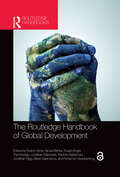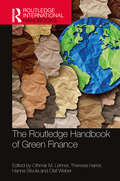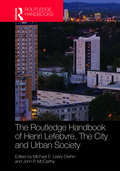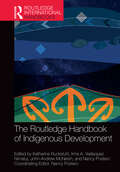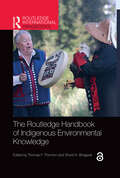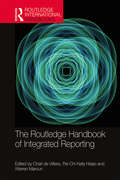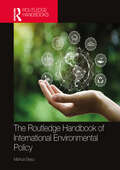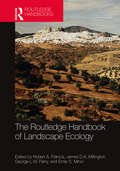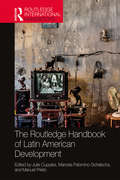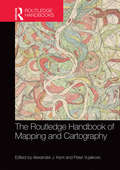- Table View
- List View
The Routledge Handbook of Democracy and Sustainability (Routledge Environment and Sustainability Handbooks)
by Basil BornemannThis handbook provides comprehensive and critical coverage of the dynamic and complex relationship between democracy and sustainability in contemporary theory, discourse, and practice. Distinguished scholars from different disciplines, such as political science, sociology, philosophy, international relations, look at the present state of this relationship, asking how it has evolved and where it is likely to go in the future. They examine compatibilities and tensions, continuities and changes, as well as challenges and potentials across theoretical, empirical and practical contexts. This wide-spanning collection brings together multiple established and emerging viewpoints on the debate between democracy and sustainability which have, until now, been fragmented and diffuse. It comprises diverse theoretical and methodological perspectives discussing democracy’s role in, and potential for, coping with environmental issues at the local and global scales. This handbook provides a comprehensive overview of arguments, claims, questions, and insights that are put forward regarding the relationship between democracy and sustainability. In the process, it not only consolidates and condenses, but also broadens and captures the many nuances of the debate. By showing how theoretical, empirical and practical accounts are interrelated, focusing on diverse problem areas and spheres of action, it serves as a knowledge source for professionals who seek to develop action strategies that do justice to both sustainability and democracy, as well as providing a valuable reference for academic researchers, lecturers and students.
The Routledge Handbook of Development and Environment (Routledge International Handbooks)
by Maano Ramutsindela Waquar Ahmed Brent McCusker Patricia SolísThe handbook seeks to illuminate the key concepts in the study of development-environment through showcasing some of the Majoritarian (formerly "Developing") world’s emerging scholars in order to explore theoretical connections through critical/radical theory, “small” theory, various conceptual frameworks, and non-Western and subaltern viewpoints. The volume examines the themes around the study of the relationship between economic and social development and the environment. Part 1 covers theoretical and conceptual approaches to the study of development and environment by examining the diverse ways in which people perceive, understand, and act upon the world around them. Cross-scalar topics such as neo-liberalism and globalization, human rights, climate change, sustainability, and technology are covered in Part 2. The book shifts to examinations of resources and production in Part 3, where authors with a focus on one or more environmental resources or types of economic production are presented. Topics range from water, agriculture, and food, to energy, bioeconomy, and mining. The fourth section presents chapters where people are at the center of the development-environment nexus through topics such as gender relations, children, health, and cities. Finally, policy and governance of development and environment are explored in Part 5. The section includes both academics and practitioners who have worked with policy makers and are policy makers themselves. The book is primarily intended for scholars and graduate students in geography, environmental studies, and development studies for whom it will provide an invaluable and up-to-date guide to current thinking across the range of disciplines, which converge in the study of development and environment.
The Routledge Handbook of Disaster Response and Recovery (Routledge International Handbooks)
by Bimal Kanti Paul Luke JuranThe Routledge Handbook of Disaster Response and Recovery covers the two post-disaster stages of the disaster cycle and presents am extensive and cutting-edge overview of their many considerations.Organized into two parts, Response and Recovery, this handbook details the history, theories, methods, debates, and emerging issues in the stages of response and recovery. Using a transdisciplinary approach, the myriad topics examined in this handbook include search and rescue, myths related to disaster response, technological methods for response, recovery among vulnerable populations, and the intersection of disasters and mental health. Contributors discuss these issues both globally as well as country- and disaster-specific.This book is an essential guide and reference not only for scholars engaged in disaster research, but also for undergraduate and graduate students, policy makers, disaster managers, international and supranational agencies, and humanitarian and volunteer organizations engaged in disaster management.
The Routledge Handbook of Disaster Risk Reduction Including Climate Change Adaptation (Routledge International Handbooks)
by Jc Gaillard Ilan Kelman Jessica MercerThe Routledge Handbook of Disaster Risk Reduction Including Climate Change Adaptation aims to provide an overview and critique of the current state of knowledge, policy, and practice, encouraging engagement, and reflection on bringing the two sectors together. This long-awaited and welcomed volume makes a compelling case that a common research agenda and a series of practical policies and policy recommendations can and should be put in place. Over 40 contributions explore DRR including CCA in five parts. The first part presents and interrogates much of the typical vocabulary seen in DRR including CCA, not only pointing out the useful and not-so-useful dimensions, but also providing alternatives and positive examples. The second part explains how to move forward creating and supporting positive crossovers and connections, while the third one explores some aspects of multi-dimensional approaches to knowing and understanding. The fourth part argues for a balanced approach to governance, taking both governmental and non-governmental governance, as well as different scales of governance, into consideration. The final part of the Handbook emphasises DRR including CCA as an investment, rather than a cost, and connects its further implementation with livelihoods of people around the world. This handbook highlights the connections amongst the processes of dealing with disasters and dealing with climate change. It demonstrates how little climate change brings which is new and emphasises the strengths of placing climate change within wider contexts in order to draw on all our strengths while overcoming limitations with specialities. It will prove to be a valuable guide for graduate and advanced undergraduate students, academics, policy makers, and practitioners with an interest in disaster risk reduction and climate change.
The Routledge Handbook of Ecomedia Studies (Routledge Environment and Sustainability Handbooks)
by Miriam Tola Stephen Rust Adrian Ivakhiv Alenda Y. Chang Antonio López Kiu-Wai ChuThe Routledge Handbook of Ecomedia Studies gathers leading work by critical scholars in this burgeoning field. Redressing the lack of environmental perspectives in the study of media, ecomedia studies asserts that media are in and about the environment, and environments are socially and materially mediated.The book gives form to this new area of study and brings together diverse scholarly contributions to explore and give definition to the field. The Handbook highlights five critical areas of ecomedia scholarship: ecomedia theory, ecomateriality, political ecology, ecocultures, and eco-affects. Within these areas, authors navigate a range of different topics including infrastructures, supply and manufacturing chains, energy, e-waste, labor, ecofeminism, African and Indigenous ecomedia, environmental justice, environmental media governance, ecopolitical satire, and digital ecologies. The result is a holistic volume that provides an in-depth and comprehensive overview of the current state of the field, as well as future developments.This volume will be an essential resource for students, educators, and scholars of media studies, cultural studies, film, environmental communication, political ecology, science and technology studies, and the environmental humanities.The Open Access version of this book, available at www.taylorfrancis. com, has been made available under a Creative Commons Attribution-Non Commercial-No Derivatives (CC-BY-NC-ND) 4.0 license. Deep gratitude for the generous support of those institutions that provided funding to enable this volume to be available simultaneously in print and open access: University of Oregon Libraries Open Access Publishing Award, Frank J. Guarini School of Busi-ness at John Cabot University, University of Vermont Humanities Center, University of California Santa Barbara, University of Lausanne, and School of Humanities at Nanyang Technological University.
The Routledge Handbook of Embodied Carbon in the Built Environment
by Alice Moncaster Rahman AzariThis handbook explores the critically important topic of embodied carbon, providing advanced insights that focus on measuring and reducing embodied carbon from across the built environment, including buildings, urban areas and cities, and construction materials and components. Split into five distinct sections, international experts, researchers, and professionals present the recent developments in the field of embodied carbon from various perspectives and at different scales of material, building, and city. Following an introduction to the embodied carbon question, the chapters in Section 1 then cover the key debates around issues such as the politics of embodied carbon, links between embodied carbon and thermal mass, and the misuse of carbon offsets. Section 2 reviews the embodied carbon policies in a selected number of countries. Sections 3, 4, and 5 approach the topic of embodied carbon from urban-, building-, and material-scale perspectives, respectively, and use case studies to demonstrate estimation techniques and present opportunities and challenges in embodied carbon mitigation. This will be important reading for upper-level students and researchers in Architecture, Urban Planning, Engineering, and Construction disciplines. Presenting case studies of embodied carbon assessment, this book will also help practicing architects, engineers, and urban planners understand embodied carbon estimation techniques and different mitigation strategies.
The Routledge Handbook of Environment and Communication
by Anders Hansen Robert CoxThis Handbook provides a comprehensive statement and reference point for theory, research and practice with regard to environment and communication, and it does this from a perspective which is both international and multi-disciplinary in scope. Offering comprehensive critical reviews of the history and state of the art of research into the key dimensions of environmental communication, the chapters of this handbook together demonstrate the strengths of multi-disciplinary and cross-disciplinary approaches to understanding the centrality of communication to how the environment is constructed, and indeed contested, socially, politically and culturally. Organised in five thematic sections, The Routledge Handbook of Environment and Communication includes contributions from internationally recognised leaders in the field. The first section looks at the history and development of the discipline from a range of theoretical perspectives. Section two considers the sources, communicators and media professionals involved in producing environmental communication. Section three examines research on news, entertainment media and cultural representations of the environment. The fourth section looks at the social and political implications of environmental communication, with the final section discussing likely future trajectories for the field. The first reference Handbook to offer a state of the art comprehensive overview of the emerging field of environmental communication research, this authoritative text is a must for scholars of environmental communication across a range of disciplines, including environmental studies, media and communication studies, cultural studies and related disciplines.
The Routledge Handbook of Environment and Communication
by Anders HansenThis revised and fully updated second edition of the Routledge Handbook of Environment and Communication provides a state-of-the-art overview of environmental communication theory, practice and research. The momentous changes witnessed in the politics of the environment as well as in the nature of media and public communication in recent years have made the study and understanding of environmental communication ever more pertinent. This is reflected in this second edition, including a number of exciting new chapters concerned with: environmental communication in an age of misinformation and fake news; environmental communication, community and social transformation; environmental justice; and advances in methods for the analysis of mediated environmental communication.Signalling the key dimensions of public mediated communication, the Handbook is organised around five thematic parts: the history and development of the field of environmental communication research, the sources, communicators and media professionals involved in producing environmental communication, research on news, entertainment media and wider cultural representations of the environment, the social and political implications of environmental communication, and the likely future trajectories for the field. Written by leading scholars in the field, this authoritative text is a must for scholars and students of environmental communication across multiple subject areas, including environmental studies, media and communication studies, cultural studies and related disciplines.
The Routledge Handbook of Environmental History (Routledge International Handbooks)
by Mark Carey Sandra Swart Emily O’Gorman William San MartínThe Routledge Handbook of Environmental History presents a cutting-edge overview of the dynamic and ever-expanding field of environmental history. It addresses recent transformations in the field and responses to shifting scholarly, political, and environmental landscapes.The handbook fully and critically engages with recent exciting changes, contextualizes them within longer-term shifts in the field, and charts potential new directions for study. It focuses on five key areas: Theories and concepts related to changing considerations of social justice, including postcolonial, antiracist, and feminist approaches, and the field’s growing emphasis on multiple human voices and agencies. The roles of non-humans and the more-than-human in the telling of environmental histories, from animals and plants to insects as vectors of disease and the influences of water and ice, the changing theoretical approaches and the influence of concepts in related areas such as animal and discard studies. How changes in theories and concepts are shaping methods in environmental history and shifting approaches to traditional sources like archives and oral histories as well as experiments by practitioners with new methods and sources. Responses to a range of current complex problems, such as climate change, and how environmental historians can best help mitigate and resolve these problems. Diverse ways in which environmental historians disseminate their research within and beyond academia, including new modes of research dissemination, teaching, and engagements with stakeholders and the policy arena. This is an important resource for environmental historians, researchers and students in the related fields of political ecology, environmental studies, natural resources management and environmental planning.Chapters 9, 10 and 26 of this book are freely available as a downloadable Open Access PDF at http://www.taylorfrancis.com under a Creative Commons Attribution-Non Commercial-No Derivatives (CC-BY-NC-ND) 4.0 license.
The Routledge Handbook of Environmental Justice (Routledge International Handbooks)
by Ryan Holifield Gordon Walker Jayajit ChakrabortyThe Routledge Handbook of Environmental Justice presents an extensive and cutting-edge introduction to the diverse, rapidly growing body of research on pressing issues of environmental justice and injustice. With wide-ranging discussion of current debates, controversies, and questions in the history, theory, and methods of environmental justice research, contributed by over 90 leading social scientists, natural scientists, humanists, and scholars from professional disciplines from six continents, it is an essential resource both for newcomers to this research and for experienced scholars and practitioners. The chapters of this volume examine the roots of environmental justice activism, lay out and assess key theories and approaches, and consider the many different substantive issues that have been the subject of activism, empirical research, and policy development throughout the world. The Handbook features critical reviews of quantitative, qualitative, and mixed methodological approaches and explicitly addresses interdisciplinarity, transdisciplinarity, and engaged research. Instead of adopting a narrow regional focus, it tackles substantive issues and presents perspectives from political and cultural systems across the world, as well as addressing activism for environmental justice at the global scale. Its chapters do not simply review the state of the art, but also propose new conceptual frameworks and directions for research, policy, and practice. Providing detailed but accessible overviews of the complex, varied dimensions of environmental justice and injustice, the Handbook is an essential guide and reference not only for researchers engaged with environmental justice, but also for undergraduate and graduate teaching and for policymakers and activists.
The Routledge Handbook of Environmental Movements (Routledge International Handbooks)
by Marco Giugni Maria GrassoThis handbook provides readers with up-to-date knowledge on environmental movements and activism and is a reference point for international work in the field. It offers an assessment of environmental movements in different regions of the world, macrostructural conditions and processes underlying their mobilization, the microstructural and social-psychological dimensions of environmental movements and activism, and current trends, as well as prospects for environmental movements and social change. The handbook provides critical reviews and appraisals of the current state of the art and future development of conceptual and theoretical approaches as well as empirical knowledge and understanding of environmental movements and activism. It encourages dialogue across the disciplinary barriers between social movement studies and other perspectives and reflects upon the causes and consequences of citizens’ participation in environmental movements and activities. The volume brings historical studies of environmentalism, sociological analyses of the social composition of participants in and sympathizers of environmental movements, investigations by political scientists on the conditions and processes underlying environmental movements and activism, and other disciplinary inquiries together, while keeping a clear focus within social movement theory and research as the main lines of inquiry. The handbook is an essential guide and reference point not only for researchers but also for undergraduate and graduate teaching and for policymakers and activists.
The Routledge Handbook of Environmental Movements (Routledge International Handbooks)
by Marco Giugni Maria GrassoThis handbook provides readers with up-to-date knowledge on environmental movements and activism and is a reference point for international work in the field. It offers an assessment of environmental movements in different regions of the world, macrostructural conditions and processes underlying their mobilization, the microstructural and social-psychological dimensions of environmental movements and activism, and current trends, as well as prospects for environmental movements and social change.The handbook provides critical reviews and appraisals of the current state of the art and future development of conceptual and theoretical approaches as well as empirical knowledge and understanding of environmental movements and activism. It encourages dialogue across the disciplinary barriers between social movement studies and other perspectives and reflects upon the causes and consequences of citizens’ participation in environmental movements and activities. The volume brings historical studies of environmentalism, sociological analyses of the social composition of participants in and sympathizers of environmental movements, investigations by political scientists on the conditions and processes underlying environmental movements and activism, and other disciplinary inquiries together, while keeping a clear focus within social movement theory and research as the main lines of inquiry.The handbook is an essential guide and reference point not only for researchers but also for undergraduate and graduate teaching and for policymakers and activists.
The Routledge Handbook of Financial Geography (Routledge Companions in Business and Management)
by Janelle Knox-Hayes Dariusz WójcikThis handbook is a comprehensive and up to date work of reference that offers a survey of the state of financial geography. With Brexit, a global recession triggered by the COVID-19 pandemic, as well as new financial technology threatening and promising to revolutionize finance, the map of the financial world is in a state of transformation, with major implications for development. With these developments in the background, this handbook builds on this unprecedented momentum and responds to these epochal challenges, offering a comprehensive guide to financial geography. Financial geography is concerned with the study of money and finance in space and time, and their impacts on economy, society and nature. The book consists of 29 chapters organized in six sections: theoretical perspectives on financial geography, financial assets and markets, investors, intermediation, regulation and governance, and finance, development and the environment. Each chapter provides a balanced overview of current knowledge, identifying issues and discussing relevant debates. Written in an analytical and engaging style by authors based on six continents from a wide range of disciplines, the work also offers reflections on where the research agenda is likely to advance in the future. The book’s key audience will primarily be students and researchers in geography, urban studies, global studies and planning, more or less familiar with financial geography, who seek access to a state-of-the art survey of this area. It will also be useful for students and researchers in other disciplines, such as finance and economics, history, sociology, anthropology, politics, business studies, environmental studies and other social sciences, who seek convenient access to financial geography as a new and relatively unfamiliar area. Finally, it will be a valuable resource for practitioners in the public and private sector, including business consultants and policy-makers, who look for alternative approaches to understanding money and finance.
The Routledge Handbook of Gender and Development (Routledge International Handbooks)
by Janet Momsen Anne Coles Leslie GrayThe Routledge Handbook of Gender and Development provides a comprehensive statement and reference point for gender and development policy making and practice in an international and multi-disciplinary context. Specifically, it provides critical reviews and appraisals of the current state of gender and development and considers future trends. It includes theoretical and practical approaches as well as empirical studies. The international reach and scope of the Handbook and the contributors’ experiences allow engagement with and reflection upon these bridging and linking themes, as well as the examining the politics and policy of how we think about and practice gender and development. Organized into eight inter-related sections, the Handbook contains over 50 contributions from leading scholars, looking at conceptual and theoretical approaches, environmental resources, poverty and families, women and health related services, migration and mobility, the effect of civil and international conflict, and international economies and development. This Handbook provides a wealth of interdisciplinary information and will appeal to students and practitioners in Geography, Development Studies, Gender Studies and related disciplines.
The Routledge Handbook of Geospatial Technologies and Society
by Alexander J. Kent Doug SpechtThe Routledge Handbook of Geospatial Technologies and Society provides a relevant and comprehensive reference point for research and practice in this dynamic field. It offers detailed explanations of geospatial technologies and provides critical reviews and appraisals of their application in society within international and multi-disciplinary contexts as agents of change. The ability of geospatial data to transform knowledge in contemporary and future societies forms an important theme running throughout the entire volume. Contributors reflect on the changing role of geospatial technologies in society and highlight new applications that represent transformative directions in society and point towards new horizons. Furthermore, they encourage dialogue across disciplines to bring new theoretical perspectives on geospatial technologies, from neurology to heritage studies. The international contributions from leading scholars and influential practitioners that constitute the Handbook provide a wealth of critical examples of these technologies as agents of change in societies around the globe. The book will appeal to advanced undergraduates and practitioners interested or engaged in their application worldwide.
The Routledge Handbook of Global Development (Routledge International Handbooks)
by Kearrin SimsThis Handbook provides a comprehensive analysis of some of the world’s most pressing global development challenges – including how they may be better understood and addressed through innovative practices and approaches to learning and teaching. Featuring 61 contributions from leading and emerging academics and practitioners, this multidisciplinary volume is organized into five thematic parts exploring: changes in global development financing, ideologies, norms and partnerships; interrelationships between development, natural environments and inequality; shifts in critical development challenges, and; new possibilities for positive change. Collectively, the handbook demonstrates that global development challenges are becoming increasingly complex and multi-faceted and are to be found in the Global ‘North’ as much as the ‘South’. It draws attention to structural inequality and disadvantage alongside possibilities for positive change. The Handbook will serve as a valuable resource for students and scholars across multiple disciplines including Development Studies, Anthropology, Geography, Global Studies, Indigenous and Postcolonial Studies, Political Science, and Urban Studies.
The Routledge Handbook of Green Finance (Routledge International Handbooks)
by Othmar M. Lehner, Theresia Harrer, Hanna Silvola and Olaf WeberGreen finance is heralded in theory and practice as the new panacea – the ideal way to support the green transition of businesses into more sustainable, environmentally responsible forms, by means of incentivized financial investments. This handbook brings together a variety of expert scholars with industry specialists to offer the most authoritative overview of green finance to date, presenting the current situation in the field. It focuses on green finance in a comprehensive way, discussing its characteristics, underlying principles, and mechanisms. The book carefully illuminates the issues surrounding green finance and delineates its boundaries, mapping out and displaying the disparate voices, traditions, and professional communities engaged in green and sustainable finance activities. Specifically, it examines the "environmental" in the environmental, social, and governance (ESG) measurements, while also discussing the interplay between each measurement. It develops a range of analytic approaches to the subject, both appreciative and critical, and synthesizes new theoretical constructs that make better sense of hybrid financial relationships. Furthermore, the handbook illustrates existing best practices and theories, and critically examines the gaps to derive the necessary future research questions. It highlights the essential issues and debates and provides a robust research agenda. As such, it helps to create an effective market for the various green financing instruments through clarification and standardization. This handbook will be the standard reference work for a broad audience, encompassing scholars, researchers, and students but also interested professionals, regulators, and policymakers wishing to orient themselves in a rapidly developing and increasingly topical field.
The Routledge Handbook of Henri Lefebvre, The City and Urban Society
by Michael E. Leary-Owhin John P. McCarthyThe Routledge Handbook of Henri Lefebvre,The City and Urban Society is the first edited book to focus on Lefebvre's urban theories and ideas from a global perspective, making use of recent theoretical and empirical developments, with contributions from eminent as well as emergent global scholars. The book provides international comparison of Lefebvrian research and theoretical conjecture and aims; to engage with and critique Lefebvre's ideas in the context of contemporary urban, social and environmental upheavals; to use Lefebvre's spatial triad as a research tool as well as a point of departure for the adoption of ideas such as differential space; to reassess Lefebvre's ideas in relation to nature and global environmental sustainability; and to highlight how a Lefebvrian approach might assist in mobilising resistance to the excesses of globalised neoliberal urbanism. The volume draws inspiration from Lefebvre's key texts (The Production of Space; Critique of Everyday Life; and The Urban Revolution) and includes a comprehensive introduction and concluding chapter by the editors. The conclusions highlight implications in relation to increasing spatial inequalities; increasing diversity of needs including those of migrants; more authoritarian approaches; and asymmetries of access to urban space. Above all, the book illustrates the continuing relevance of Levebvre's ideas for contemporary urban issues and shows – via global case studies – how resistance to spatial domination by powerful interests might be achieved. The Handbook helps the reader navigate the complex terrain of spatial research inspired by Lefebvre. In particular the Handbook focuses on: the series of struggles globally for the 'right to the city' and the collision of debates around the urban age, 'cityism' and planetary urbanisation. It will be a guide for graduate and advanced undergraduate teaching, and a key reference for academics in the fields of Human Geography, Sociology, Political Science, Applied Philosophy, Planning, Urban Theory and Urban Studies. Practitioners and activists in the field will also find the book of relevance.
The Routledge Handbook of Indigenous Development (Routledge International Handbooks)
by Nancy Postero John-Andrew McNeish Katharina Ruckstuhl Irma A. Velásquez NimatujThis Handbook inverts the lens on development, asking what Indigenous communities across the globe hope and build for themselves. In contrast to earlier writing on development, this volume focuses on Indigenous peoples as inspiring theorists and potent political actors who resist the ongoing destruction of their livelihoods. To foster their own visions of development, they look from the present back to Indigenous pasts and forward to Indigenous futures. Key questions: How do Indigenous theories of justice, sovereignty, and relations between humans and non-humans inform their understandings of development? How have Indigenous people used Rights of Nature, legal pluralism, and global governance systems to push for their visions? How do Indigenous relations with the Earth inform their struggles against natural resource extraction? How have native peoples negotiated the dangers and benefits of capitalism to foster their own life projects? How do Indigenous peoples in diaspora and in cities around the world contribute to Indigenous futures? How can Indigenous intellectuals, artists, and scientists control their intellectual property and knowledge systems and bring into being meaningful collective life projects? The book is intended for Indigenous and non-Indigenous activists, communities, scholars, and students. It provides a guide to current thinking across the disciplines that converge in the study of development, including geography, anthropology, environmental studies, development studies, political science, and Indigenous studies.
The Routledge Handbook of Indigenous Environmental Knowledge (Routledge International Handbooks)
by Thomas F. Thornton Shonil A. BhagwatThis volume provides an overview of key themes in Indigenous Environmental Knowledge (IEK) and anchors them with brief but well-grounded empirical case studies of relevance for each of these themes, drawn from bioculturally diverse areas around the world. It provides an incisive, cutting-edge overview of the conceptual and philosophical issues, while providing constructive examples of how IEK studies have been implemented to beneficial effect in ecological restoration, stewardship, and governance schemes. Collectively, the chapters in the Routledge Handbook of Indigenous Environmental Knowledge cover Indigenous Knowledge not only in a wide range of cultures and livelihood contexts, but also in a wide range of environments, including drylands, savannah grassland, tropical forests, mountain landscapes, temperate and boreal forests, Pacific and Indian Ocean islands, and coastal environments. The chapters discuss the complexities and nuances of Indigenous cosmologies and ethno-metaphysics and the treatment and incorporation of IEK in local, national, and international environmental policies. Taken together, the chapters in this volume make a strong case for the potential of Indigenous Knowledge in addressing today’s local and global environmental challenges, especially when approached from a perspective of appreciative inquiry, using cross-cultural methods and ethical, collaborative approaches which limit bias and inappropriate extraction of IEK. The book is a guide for graduate and advanced undergraduate teaching, and a key reference for academics in development studies, environmental studies, geography, anthropology, and beyond, as well as anyone with an interest in Indigenous Environmental Knowledge.
The Routledge Handbook of Integrated Reporting (Routledge International Handbooks)
by Charl De VilliersThis timely handbook provides a current and comprehensive examination of integrated reporting, both practical and research-based. It offers insights and different perspectives from more than 60 authors, including representatives of the International Integrated Reporting Council, Integrated Reporting Committee of South Africa, professional bodies and audit firms, as well as leading academics in the fields of integrated reporting, sustainability reporting and corporate social responsibility. This collected work provides an in-depth review of the development of integrated reporting, with a focus on the interpretation and guidance provided by the International Integrated Reporting Council. It encourages the development of new thinking and research topics in the area of integrated reporting (such as links between integrated reporting and reports focused on financial and corporate social responsibility matters), as well as showcasing how integrated reporting issues are seen and practiced in different parts of the world. The chapters include reviews of the most recent research, practitioner viewpoints, conceptual pieces, case studies and disclosure analyses. Accessible and engaging, this handbook will be an invaluable overview for those new to the field or those who are interested in ensuring they are up to date with its developments, as well as those who are concerned with how to construct an integrated report.
The Routledge Handbook of International Environmental Policy
by Mahua BasuThis handbook is a one-stop, comprehensive guide to global initiatives for climate action. It examines policies to tackle climate change and the critical role various organizations play.The volume: Includes in-depth discussion of individual issues related to the environment Highlights global initiatives, negotiations, and international organizations responsible for climate action, protecting marine and freshwater environment, protecting atmosphere and climate, conserving biological diversity, chemicals and wastes management, environmental governance, safeguarding against warfare and disasters Debates on-ground implications of the international policies for the Global South Brings together case studies from across the world Presents a toolkit for environment practitioners to seek sustainable and practicable solutions to problems Includes suggested readings for researchers Brings together primary documents, supportive illustrations, graphs, and maps The handbook will be an essential reference for scholars and researchers of environmental studies, environmental policy and governance, sustainability and resilience. It will also be indispensable for policy makers, think tanks and NGOs.
The Routledge Handbook of Landscape Ecology
by Robert A. Francis, James D.A. Millington, George L.W. Perry, and Emily S. MinorThe Handbook provides a supporting guide to key aspects and applications of landscape ecology to underpin its research and teaching. A wide range of contributions written by expert researchers in the field summarize the latest knowledge on landscape ecology theory and concepts, landscape processes, methods and tools, and emerging frontiers. Landscape ecology is an interdisciplinary and holistic discipline, and this is reflected in the chapters contained in this Handbook. Authors from varying disciplinary backgrounds tackle key concepts such as landscape structure and function, scale and connectivity; landscape processes such as disturbance, flows, and fragmentation; methods such as remote sensing and mapping, fieldwork, pattern analysis, modelling, and participation and engagement in landscape planning; and emerging frontiers such as ecosystem services, landscape approaches to biodiversity conservation, and climate change. Each chapter provides a blend of the latest scientific understanding of its focal topics along with considerations and examples of their application from around the world. An invaluable guide to the concepts, methods, and applications of landscape ecology, this book will be an important reference text for a wide range of students and academics in ecology, geography, biology, and interdisciplinary environmental studies.
The Routledge Handbook of Latin American Development (Routledge International Handbooks)
by Julie Cupples Marcela Palomino-Schalscha Manuel PrietoThe Routledge Handbook of Latin American Development seeks to engage with comprehensive, contemporary, and critical theoretical debates on Latin American development. The volume draws on contributions from across the humanities and social sciences and, unlike earlier volumes of this kind, explicitly highlights the disruptions to the field being brought by a range of anti-capitalist, decolonial, feminist, and ontological intellectual contributions. The chapters consider in depth the harms and suffering caused by various oppressive forces, as well as the creative and often revolutionary ways in which ordinary Latin Americans resist, fight back, and work to construct development defined broadly as the struggle for a better and more dignified life. The book covers many key themes including development policy and practice; neoliberalism and its aftermath; the role played by social movements in cities and rural areas; the politics of water, oil, and other environmental resources; indigenous and Afro-descendant rights; and the struggles for gender equality. With contributions from authors working in Latin America, the US and Canada, Europe, and New Zealand at a range of universities and other organizations, the handbook is an invaluable resource for students and teachers in development studies, Latin American studies, cultural studies, human geography, anthropology, sociology, political science, and economics, as well as for activists and development practitioners.
The Routledge Handbook of Mapping and Cartography
by Alexander J. Kent Peter VujakovicThis new Handbook unites cartographic theory and praxis with the principles of cartographic design and their application. It offers a critical appraisal of the current state of the art, science, and technology of map-making in a convenient and well-illustrated guide that will appeal to an international and multi-disciplinary audience. No single-volume work in the field is comparable in terms of its accessibility, currency, and scope. The Routledge Handbook of Mapping and Cartography draws on the wealth of new scholarship and practice in this emerging field, from the latest conceptual developments in mapping and advances in map-making technology to reflections on the role of maps in society. It brings together 43 engaging chapters on a diverse range of topics, including the history of cartography, map use and user issues, cartographic design, remote sensing, volunteered geographic information (VGI), and map art. The title’s expert contributions are drawn from an international base of influential academics and leading practitioners, with a view to informing theoretical development and best practice. This new volume will provide the reader with an exceptionally wide-ranging introduction to mapping and cartography and aim to inspire further engagement within this dynamic and exciting field. The Routledge Handbook of Mapping and Cartography offers a unique reference point that will be of great interest and practical use to all map-makers and students of geographic information science, geography, cultural studies, and a range of related disciplines.
